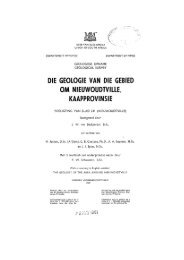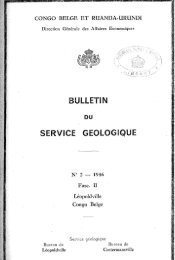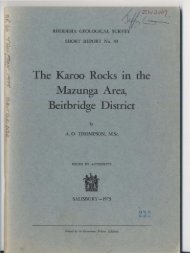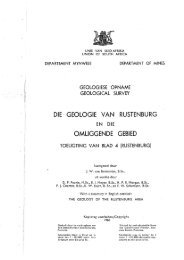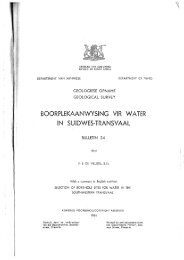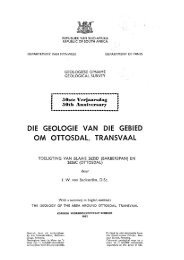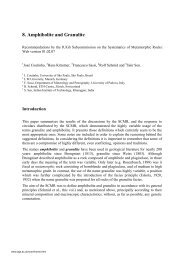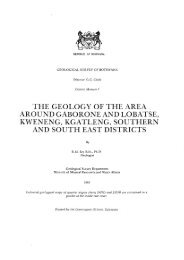Bibliography - British Geological Survey
Bibliography - British Geological Survey
Bibliography - British Geological Survey
Create successful ePaper yourself
Turn your PDF publications into a flip-book with our unique Google optimized e-Paper software.
Bowler, P. J. 1992 (contribution to discussion in Tobias 1992c)<br />
Boylan, P. 2004. Museum specimens as sacred objects: the contrasting treatment of the Piltdown fraud of<br />
1912 and that of Moulin Quignon, 1863. In: Geofakes, frauds and hoaxes, abstracts of a meeting organised<br />
by the History of Geology Group, under the aegis of the <strong>Geological</strong> Society of London, Burlington House,<br />
London, 22 October 2004, p. 5. (‘Since the first exposure of the enormity of the Piltdown Man forgery fifty<br />
years ago, both scientific and popular literature has focused almost exclusively on attempts to unmask the<br />
forger. However, there is a much more fundamental question that ought to be asked: how could such a crude<br />
forgery be accepted by so many of the scientific community in the first place and then escape serious review,<br />
let alone detection, for a further 40 years? ...The very uncomfortable conclusion is that the rapid development<br />
of museum curatorship concepts between 1893 and 1912 created an atmosphere in which the Piltdown ‘finds’<br />
were never seriously regarded as scientific objects requiring dispassionate investigation. Instead, they were<br />
treated more as sacred relics, not to be defiled by proper scientific investigation of evaluation, while international<br />
politics, or at least prestige, were also in play. We need to constantly ask ourselves, as scientists,<br />
whether we are today being just as gullible in the face of contemporary scientific frauds or myths.’ On this<br />
last point see, for example, Morwood & Oosterzee 2007, and Henneberg et al. 2011)<br />
Brannigan, A. 1981. The social basis of scientific discoveries. Cambridge University Press. (Piltdown Man,<br />
pp. 133–142)<br />
Breuil, H. 1922. In: Revue anthropologique, July-Aug, p. 229. (Argues that the so-called worked bone<br />
implement from Piltdown is the result of gnawing by beaver or Trogontherium, beaver remains having been<br />
reported from the same bed)<br />
Breuil, H. 1938. The use of bone implements in the Old Palaeolithic period. Antiquity, 12, no. 45, 56‒67,<br />
plates I‒IV. (Translation from the French of a paper read at the International Congress of Prehistoric and<br />
Protohistoric Science at Oslo, 1936. Breuil once again dismisses the Piltdown bone implement as the work<br />
of a large species of beaver, p. 59.)<br />
Breuil, H. 1949. Silex taillés de Piltdown (Sussex). Bulletin de la Société préhistorique Française, 46,<br />
344‒348.<br />
Broad, W. & Wade, N. 1982. Betrayers of the truth. New York: Simon & Schuster, 256 pp. (The motives<br />
that lead to fraud and deceit in science are examined, and notable examples cited. Scientists consider themselves<br />
to be the principal arbiters of truth and objectivity―yet this is demonstrably a self deception. The oftenmade<br />
claim that scientific research proceeds in a rational way is likewise shown to be a myth. ‘Expectancy<br />
leads to self-deception, and self-deception leads to the propensity to be deceived by others. The great scientific<br />
hoaxes, such as the Beringer case and the Piltdown man... demonstrate the extremes of gullibility to which<br />
some scientists may be led by their desire to believe.’ The Piltdown ‘dawn man’ emerged at a time of <strong>British</strong><br />
national pride when the Empire was at its height, and was thus eagerly embraced as proof that England had<br />
been the cradle of world civilisation.)<br />
Broek, A. J. P. van den 1921. Onze tegenwoordige kennis van den voor-historischen mensch. Tijdschrift<br />
van het K. Nederlandsch Aardrijkskundig Genootschap, ser. 2, 38, 355–389. (Adopts Boule’s attribution of<br />
the Piltdown jaw to Troglodytes dawsoni, pp. 370–71, 374)<br />
Brook, A. 2004. Piltdown and Sussex: an uneasy relationship. In: Geofakes, frauds and hoaxes, abstracts of<br />
a meeting organised by the History of Geology Group, under the aegis of the <strong>Geological</strong> Society of London,<br />
Burlington House, London, 22 October 2004, pp. 5–6. (An examination of the Sussex County Magazine,<br />
published 1926–1956, reveals a number of previously unnoticed papers connected with the Piltdown finds<br />
(Martin 1943; Kenward 1955). By contrast, the Sussex Archaeological Society were dismissive of Dawson<br />
and disregarded the whole Piltdown controversy, although an intriguing notice has been discovered in the<br />
Society’s Newsletter of April 1980: see Holden 1980a.)<br />
Broom, R. 1918. The evidence afforded by the Boskop skull of a new species of primitive man (Homo<br />
capensis). Anthropological Papers of the American Museum of Natural History, 23 (2), 63–79.<br />
(Comparison with Piltdown, p. 78)<br />
Broom, R. 1933. The coming of man, was it accident or design? London: H. F. & G. Witherby, 238 pp.<br />
(Eoanthropus dawsoni, pp. 153‒156. Includes a restored profile of the Piltdown skull (Fig. 27) modified<br />
after Smith Woodward. The author notes how closely the arrangement of structures round the large nerve<br />
opening at the back of the jaw resembles that of the chimpanzee. ‘The affinities of the Piltdown skull are



